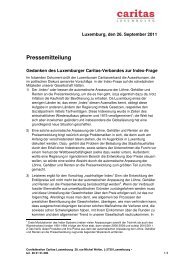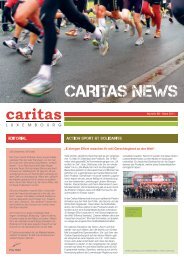Sozialalmanach - Caritas Luxembourg
Sozialalmanach - Caritas Luxembourg
Sozialalmanach - Caritas Luxembourg
Create successful ePaper yourself
Turn your PDF publications into a flip-book with our unique Google optimized e-Paper software.
is, of course, no such thing as an institutional regime for all seasons. In the late 1960s, the<br />
post-war celebration of unprecedented growth and social solidarity through democratic<br />
politics was already giving way to doubts. Rising inflation as a result of wage explosion and<br />
the resurgence of worker militancy and social protest confronted the sober and consensual<br />
political economies of the post-war era with a new political context, reflecting the new<br />
levels of economic prosperity and social expectations. The era of embedded liberalism<br />
came to end in the mid-1970s as the two oil shocks of the 1970s revealed contradictions<br />
in the mixed economy and welfare-friendly regime of embedded liberalism; specifically,<br />
its inability to contain inflation under conditions of near-full employment. Furthermore,<br />
increasing international competition and de-industrialisation came to undermine the<br />
effectiveness of domestic Keynesian demand management. This led to a massive surge in<br />
unemployment, not seen since the 1930s. As Keynesian economists continued to analyse<br />
macroeconomic performance in terms of a trade-off between employment and inflation,<br />
they lost their intellectual edge. After the second oil shock in 1979 led to tightened fiscal<br />
and monetary policies in the early 1980s, the world economy entered its most severe slump<br />
since the 1930s. High inflation, mass unemployment, and sluggish growth provided an<br />
opportunity for an intellectual and political break with ‘embedded liberalism’.<br />
The crisis of stagflation thus set the stage for a political return to more unfettered market<br />
economies, away from public ownership, excessive regulation, and generous levels of social<br />
protection. The election of Margaret Thatcher and Ronald Reagan, in 1979 and 1980<br />
respectively, brought the belief in the primacy of self-regulating markets and a minimal state<br />
back into the limelight. The state was identified as the source of the problem of stagflation,<br />
as it was believed to distort the natural workings of the market. Beginning in the 1980s and<br />
gathering momentum in the 1990s, neoliberal doctrines of fiscal discipline, low inflation,<br />
financial liberalisation, labour market deregulation, privatisation, and the marketisation<br />
of welfare provision from regulatory constraints, gained precedence in the management of<br />
advanced market economies. However, it should be remembered that neo-liberalism did not<br />
spell the waning of state activism, but instead the redeployment of government initiatives<br />
to the new mission of liberalisation, deregulation and privatisation. State authorities shifted<br />
from a market-steering orientation to a market-supporting orientation.<br />
Neo-liberalism lasted until the onslaught of the current crisis. What neo-liberalism<br />
stands for exactly is far from unanimously accepted. This is because neo-liberalism, unlike<br />
the academic concept of ‘embedded liberalism’, is most often used to denote an<br />
ideological political position. At a very general level, I associate neo-liberalism 9 with the<br />
secular expansion of market relations inside and across the borders of national political<br />
9 Based on the ideas of Wolfgang Streeck and Kathy Thelen (2005).<br />
153








